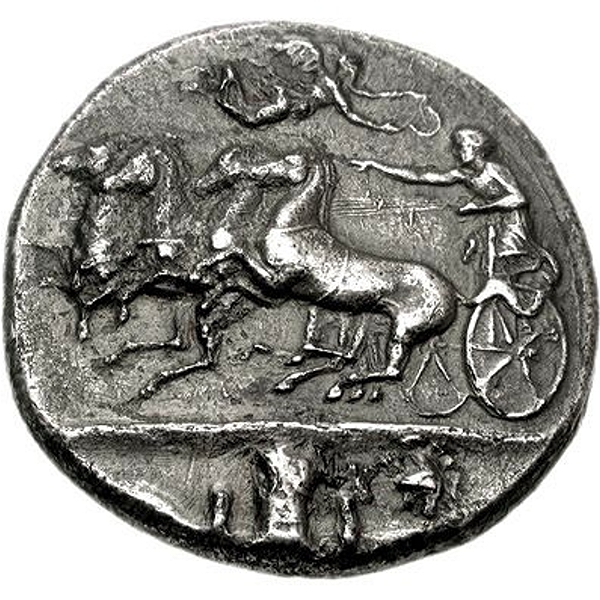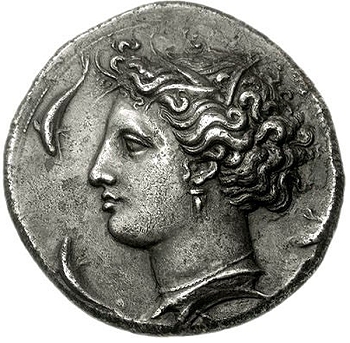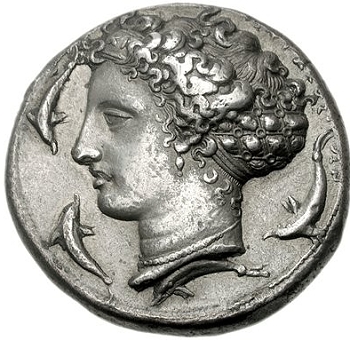
Classic example of a decadrachm with Euainetos-signed dies.
By Josh Illingworth, NGC Ancients ………
NGC Ancients examines the series of silver decadrachms struck at Syracuse (Sicily) in the fifth to fourth centuries BCE
During the time of Dionysius I (c. 405-367 BCE), a beautiful series of large silver coins were introduced at Syracuse, the chief city of Sicily. They are considered to be among the great artistic masterpieces of ancient coinage. These coins, called decadrachms, were equal to 10 drachms of the Attic weight standard (roughly 4.3 grams), and as such tend to weigh between 42 and 43 grams. For purposes of comparison, they are slightly larger, much thicker and about one-and-a-half times as heavy as the US Morgan Dollar.
The decadrachms of Syracuse were struck with dies prepared by master Sicilian engravers, pocket-sized examples of a pinnacle of ancient Greek art. Some engravers were proud enough of their work that they would occasionally sign their dies, a practice largely restricted to the Greeks. Two names in particular, those of Euainetos and Kimon, have been preserved through the millennia by their signatures on coins, including decadrachms.
 The first coin illustrated here is a classic example of a decadrachm with Euainetos-signed dies. The coin features on the obverse a charioteer in a quadriga (a four-horse chariot), with Nike crowning the driver from above. Below the exergual line appear various kinds of armor connected by a horizontal spear. The reverse of the coin bears the portrait of a divinity usually described as Arethusa, surrounded by four dolphins. If one looks very closely beneath the dolphin under Arethusa’s neck, the faintest traces of the signature of Euainetos may be seen.
The first coin illustrated here is a classic example of a decadrachm with Euainetos-signed dies. The coin features on the obverse a charioteer in a quadriga (a four-horse chariot), with Nike crowning the driver from above. Below the exergual line appear various kinds of armor connected by a horizontal spear. The reverse of the coin bears the portrait of a divinity usually described as Arethusa, surrounded by four dolphins. If one looks very closely beneath the dolphin under Arethusa’s neck, the faintest traces of the signature of Euainetos may be seen.
It is of some interest that on Syracusan silver coins of this era, the “heads” side is actually the reverse, and the chariot the obverse. This is the opposite of tradition at most Greek mints of the time, and resulted from the earliest Syracusan coins having only one side with a design, which happened to be a chariot scene. The head of Arethusa eventually was incorporated into the reverse, and there it remained until the Syracusan king Agathocles made the head the obverse starting in about 317 BCE.
The next coin is the work of the engraver Kimon, whose decadrachms are generally considered to have been introduced shortly before those of Euainetos. Though the basic elements of the design are the same (i.e. charioteer obverse/Arethusa reverse), the style of the hair is markedly different and becomes readily apparent when compared with the above coin by Euainetos.
 On the Kimon piece, Arethusa’s hair is slightly more compacted and restrained by an ampyx (rather than a wreath of grain ears), the ancient equivalent of a hairband. Kimon’s signature appears at the top of the ampyx (just above the top of Arethusa’s forehead) as a neat “KI” placed on the band.
On the Kimon piece, Arethusa’s hair is slightly more compacted and restrained by an ampyx (rather than a wreath of grain ears), the ancient equivalent of a hairband. Kimon’s signature appears at the top of the ampyx (just above the top of Arethusa’s forehead) as a neat “KI” placed on the band.
Based on the distinction in style, these coins can be attributed with confidence to one of these two master engravers, even when struck with dies on which no signature appears. The metal quality of the coins is usually quite sound; however, die rust is an unfortunate problem throughout the series. Coins may be encountered in very different states because of the rapid deterioration of the dies.
Well-centered strikes command a premium, especially since the chariot die can often be quite worn. However, because of their relative rarity and great artistic merit, these coins are today highly valued in any condition by collectors, and are eagerly sought whenever they appear on the market.
NGC Ancients has examined and graded many Syracusan decadrachms, one of which (it happens to be an excellent example of the issue) is pedigreed to the ANA Money Museum Collection. This particular piece, likely struck between 405-390 BCE, bears the signature of Euainetos, though only the top of some of the letters were actually impressed onto the planchet when the coin was struck. In this case, the head of Arethusa is displayed upward, even though it is the reverse, since many collectors prefer the portrait to the chariot scene.
Ironically, the decadrachms of Syracuse were probably struck for the rather mundane purpose of paying mercenaries. Most of the issues likely had a very short circulation life and were subsequently melted, accounting for their relative rarity today (this in addition to their status as high denomination coins, a factor that usually generates rarity by itself). Nonetheless, the obverse and reverse types were well known throughout the ancient world and would prove to be enormously influential on subsequent coinage, even centuries later. The portrait, in particular, was adopted by die engravers throughout the Greek world. One example is this silver stater of c.370-360 BCE from Larissa, a city of Thessaly in mainland Greece, which portrays the nymph Larissa based upon the composition of Euainetos.
Today, the decadrachms of Syracuse are highly prized by collectors for their artistic beauty, historical importance, and rarity. They serve as physical reminders of the enormous talents of ancient Greek artists, the technical expertise of the minters, and the cultural achievement that it represents.




